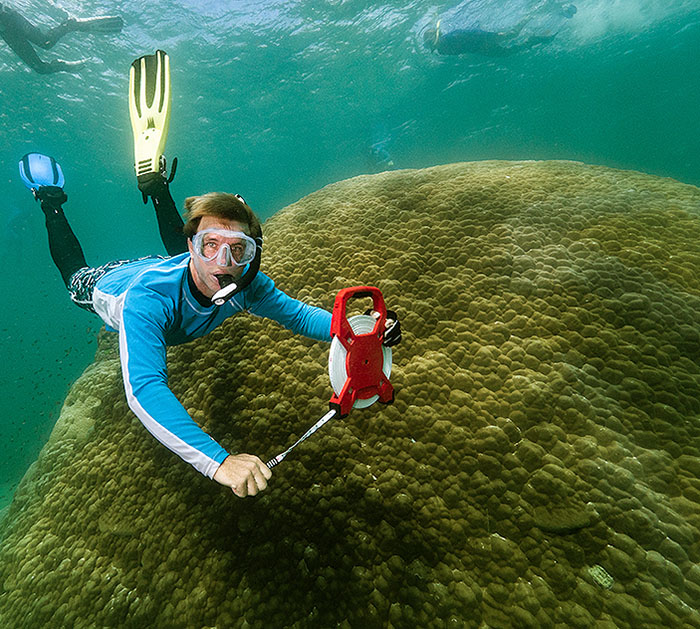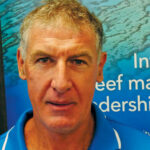An exceptionally large coral has been discovered on the Great Barrier Reef— it’s more than 400 years old and nearly 8 feet (2.5 metres) wider than any other coral measured in Australian waters. Images: Richard Woodgett
James Cook University Adjunct Associate Professor Dr. Adam Smith said the coral, so far identified only as Porites sp., was discovered by scientists and community members participating in a marine citizen science course with Reef Ecologic.
“It’s hemispherical, 5.3 meters tall and 10.4 meters wide, which makes it 2.4 meters wider than the next-widest coral measured in the Great Barrier Reef,” said Dr. Smith. “Using calculations based on rock coral growth rates and annual sea surface temperatures, we think it’s between 421 and 438 years old and predates European exploration and settlement of Australia.”
In English measurements, the behemoth bommie measures more than 34 feet in diameter, stands 17 feet high and has an estimated volume of about 15,800 cubic—or about 120,000 gallons. If it started life in about 1590 AD, North America was populated by native peoples and the Roanoke Colony in Virginia had failed.

Christened Muga Dhambi (Big Coral)
The coral was discovered by snorkelers undertaking citizen science research off the coast of Goolboodi (also known as Orpheus Island), part of the Palm Island Group in Queensland. It has been named Muga Dhambi (Big Coral) by the Manbarra people, the traditional custodians of the Palm Islands.
The Porites is located within a reef slope, on a sandy habitat in a maximum water depth of 7.4 m and the top of the bommie was 2.1 m below the surface (2.0 m tide).
“Muga Dhambi may have survived up to 80 major cyclones, numerous coral bleaching events and centuries of exposure to invasive species, low tides and human activity. Despite this, it’s in very good health with 70% consisting of live coral,” said Dr. Smith.
The coral is described in the journal Scientific Reports. Dr Smith said the team of scientists and authors who contributed to the paper ranged from 17-year-old Kailash Cook to 76-year-old Dr. Charlie Veron.
“It’s been an honour to document such a magnificent piece of our Great Barrier Reef. Having a publication with Charlie Veron, the godfather of coral, is a once in a lifetime opportunity that I will never forget.

“Spending time monitoring, exploring and sharing knowledge about the reefs of Goolboodi island with the Reef Ecologic team was an invaluable experience that excites me for a future in the marine science world,” said Dr. Smith.
The authors recommend monitoring the rare and unusually resilient large coral and said that with increasing threats from the negative impacts of climate change, declining water quality, overfishing and coastal development, restorative activities may be required to assist the recovery of the Great Barrier Reef, including the protection of corals like Muga Dhambi.
Dr. Smith said he is proud of the scientific discovery of this coral and the collaboration with traditional owners.
“I recognise that the biggest threat to the Great Barrier Reef is climate change and I am pleased to report that the greenhouse gas emissions of this research were measured and offset as part of our carbon positive policy. Great science is about knowledge and sustainability of the planet.”
REFERENCES
Smith, A., Cook, N., Cook, K. et al. Field measurements of a massive Porites coral at Goolboodi (Orpheus Island), Great Barrier Reef. Sci Rep 11, 15334 (2021). https://doi.org/10.1038/s41598-021-94818-w






